Real Estate and Facilities Master Plan
The 2018 Real Estate Facilities Strategy identified that the District's facilities had reached a critical state: 75% of the District’s facilities are 25 years or older. A preliminary review of the capacity, function and condition of the District’s existing facilities identified that at least seven of the District’s 13 operational facilities are candidates for replacement and three additional facilities are exceeding capacity.
The 2019 Real Estate and Facilities Master Plan (REFMP) identified the 'what, when and how' the District would implement the Strategy. Since then, the District has commenced an unprecedented period of facility analysis, design and construction.
Pre-Development Project
The District of Squamish is embarking on the next phase of facility investments in Squamish and reviewing municipal facilities and land requirements in a fiscally responsible manner.
On April 18, 2023, Council approved an amendment to the 2023-2027 Financial Plan Bylaw to support a REFMP Pre-Development project to undertake the necessary due diligence to:
- Determine the feasibility of the Civic Block and future additional Brennan Park Recreation Centre upgrade projects.
- Conduct due diligence for an Innovation Area to maximize economic development on District-owned lands in the Squamish Business Park.
The next phase of decision-making involves the replacement of the current Municipal Offices, potentially as part of a larger new Civic Block that could include an expanded Squamish Public Library and community centre, co-location with government and non-government entities such as School District 48, and collaboration with arts, culture and heritage uses under the GLAM (Gallery, Library, Archive and Museum) umbrella.
More information from the Pre-Development Project will be provided to the public in 2024. Decisions on the replacement of the Municipal Offices, timing of future replacements at Brennan Park and timing, scope and locations for the remainder of the Civic Block are expected to be mapped out in summer 2024.
REFMP Projects
Project Details
Essential Services First
Three critical facilities were identified in need of priority replacement in the 2019 Real Estate and Facilities Master Plan.
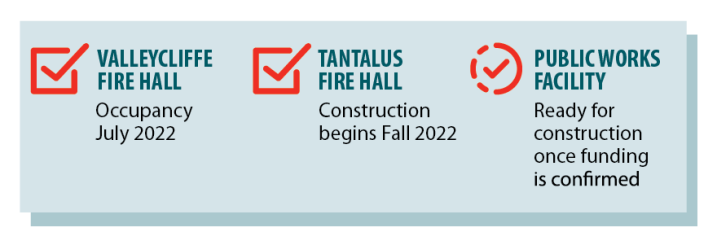
REFMP information
All Works (Preliminary) Sustainability Baselines
- +85% landfill waste diversion during demolition and construction
- +50% water reduction
- 95th percentile stormwater management (via detention/infiltration)
- Use of carbon embodied material where possible
- Plant based
- Carbon retention methods
Will be the subject of Council approval in the near future.
Public Works:
For the office area:
- Referencing the 2018 (BC Building Code BCBC)) table 10.2.3.3-I Energy Performance Requirements for Offices for climate zone 4 (HDD < 3000), Step 3 is the highest performance level defined
- Office proposed design target to 20% better than Step Code 3 (BCBC))
- Design new PW office to be all electric
- For building envelope airtightroof ness, proceed as per 10.2.3.5. of the BCBC 2018 (measure actual airtightness within specified pressure threshold and input the value into the energy model; compare model results obtained using actual airtightness to performance targets);
For the maintenance bays area:
- For reference, automotive garages are not covered in Part 10 Energy Efficiency of the BCBC
- BCBC specifies conforming to Part 8 of the National Energy Code of Canada for Buildings (NECB) for building types / major occupancies for which ESC does not apply
- Referencing NRCan NEUD (Natural Resources Canada – National Energy Use Database) for Transportation and Warehousing facilities, and cross referencing with existing PW / Fleet Shop energy data, using an all-electric building
Tantalus Fire Hall
- Being an IPD setup, staff simplified the targets for the design/consultant/build team at 20% better than Step Code 3 (BC Building Code) rating, but are pushing for Passive House standards if feasible. This collaborative approach will help determine that the District gets the most amount of substantiality for the cost, whilst tracking to meet MEEP/CCAP levels in 2030.
Grants in place
- Brennan Park Retrofit/Renovation, GICB grant, $16.7M total project cost – approved and project moving forward
Grants in application/waiting
- CleanBC Community Fund for $14M total project - answer expected late 2023
Integrated Project Delivery (IPD)
A single contractual arrangement between the architect, builder, consultants and main trades where they all share in the profit and risk of a project. It uses a construction scheduling system that is more accurate than traditional systems (such as Microsoft Project) and holds all parties accountable to meet costs and timing deadlines.
It is becoming popular in many Government jobs (first one in Canada was a hospital in Moose Jaw, 2012) above $10m. It is an alternative system to the traditional Construction Management method (where an architect is contracted separately and at differing times to the builder and consultants) but has also been standardized through the Canadian Construction Documents Committee (CCDC – the main supplier of contracts in the construction industry).
Value Engineering (VE)
Process of finding a cheaper way to construct. By reducing square meters, changing scope or by finding alternative material selections / construction methods.
Class Budgets
A method to formalize the budget process. From the Royal Architect Institute of Canada (RAIC):
- Class “D” (Indicative) Estimate
“Based upon a comprehensive statement of requirements, an outline of potential solutions and/or functional program, this estimate is to provide an indication of the final project cost that will enable ranking to be made for all the options being considered. This cost estimate shall be prepared in elemental analysis format. The level of accuracy of a Class D cost estimate shall be such that no more than a 20% design allowance is required.” - Class “C” Estimate
“Based on schematic/conceptual design and/or comprehensive list of project requirements, this estimate shall be adequately detailed and shall be sufficient for making the correct investment decision. This cost estimate shall be based on measured quantities of all items of work and prepared Public Services and Procurement Canada Page 13 in elemental analysis format. The level of accuracy of a Class C cost estimate shall be such that no more than a 15% design allowance is required.” - Class “B” (Substantive) Estimate
“Based on design development drawings and outline specifications, which include the preliminary design of all major systems and subsystems, as well as the results of all site/installation investigations, this estimate shall provide for the establishment of realistic cost objectives and be sufficient to obtain effective project approval. This cost estimate shall be based on measured quantities of all items of work and prepared in elemental analysis format. The level of accuracy of a Class B cost estimate shall be such that no more than a 10% design allowance is required.” - Class “A” (Pre-tender) Estimate
“Based on completed construction drawings and specifications prepared prior to calling competitive tenders, this estimate shall be sufficient to allow a detailed reconciliation and/or negotiation with any contractor’s tender submission. This cost estimate shall be based on fully measured quantities of all items of work and prepared in both elemental analysis and Trade division format as per MasterFormatTM. The level of accuracy of a Class A cost estimate shall be such that no more than a 5% design allowance is required.”
With 75% of municipal facilities at end of life, the community is faced with $200M +/- in facilities upgrades to service our growing community. Reserves and land sales are estimated at $60M, leaving a $140M funding gap.
The District has commenced an unprecedented period of facility analysis, design and construction through the development of the Real Estate and Facilities Strategy (2018) and then the adoption of a Master Plan in 2019.
- Needs were prioritized into Critical, Core and Support categories.
- A funding gap of $140M +/- (2022 dollars) was identified and a plan was developed to close the gap through tough decisions, trade-offs and creative ways to leverage both internal and external funding sources, especially given the many other major projects outlined in the 10-Year Capital Plan.
- Every facility is important —but we can’t do them all at once. Priorities are assessed by community safety, urgency (building end-of-life) and funding availability. For example: recreation centres can attract grants, while city halls and public works facilities cannot. This is a key factor in prioritizing available funds.
How did we get here?
Over decades, the lack of planning and budgeting to build reserves for the eventual need to replace facilities has resulted in the current need for significant financial investments now and in the coming years. Read our "How We Got Here" backgrounder for more information.
About the Real Estate and Facilities Master Plan
Council endorsed the District of Squamish Real Estate and Facilities Strategy (REFS) in the spring of 2018. The REFS identifies that many of the District’s facilities may require the replacement or upgrade/expansion in order to meet the community’s current and long-term needs, as many are reaching end of life, have reached maximum capacity, and are insufficient for a rapidly growing community. An investment in excess of $150m+ has been identified for facilities in need of such replacement or upgrade/expansion.
In order to support the decision making that lies ahead, the REFS identifies strategic principles and an implementation approach aimed at minimizing the upcoming investment into facilities and land and to ensure the District is providing the necessary services to the community in a fiscally responsible manner over the next 25 years.
In July 2019, Council endorsed the District of Squamish Real Estate and Facilities Master Plan (REFMP), which was the next step identified by the REFS.
The REFMP identifies:
- “What” facilities and land investments need to be made;
- “When” those investments are recommended to be made and;
- “How” much funding exists to support these investments.
Timeline and Process
| Fall 2019 | Findings from REFMP will be incorporated into Long-Term Financial Plan and Annual Budget processes (annually, for the upcoming five years). |
| July 2019 | Council adopted the Real Estate and Facilities Master Plan (REFMP). |
| Spring 2019 | Community and partner engagement - Two Requests of Expressions of Interest were issued (1) Seeking innovative funding and partnering proposals for Brennan Park lands; (2) Testing the waters to see what level of interest there may be in the District-owned properties in the Business Park. This land could be sold or leased to fund future investments in facilities. |
| Fall 2018 | Community Engagement for Brennan Park. |
| April 2018 | Council adopted the Real Estate and Facilities Strategy (REFS). |
The District has commenced an unprecedented period of facility analysis, design and construction. The District has retained the required in‐house project management resources to support this process. These activities are anticipated to be focused as follows:
|
Year |
Focus |
Activities |
|
1 |
Due Diligence |
Final site analysis, partnership and grant funding opportunities, final needs assessments, Disposition Strategy |
|
2 |
Decision Making |
Options analysis, community engagement and Council endorsements in budget |
|
3+ |
Project Work |
Detailed design, tendering and construction |
The REFMP included funding illustrations to support future decision making which will require updating to reflect the many external factors impacting the District’s ability to fund future investments including:
- market values of District Dispositions;
- contributions from development;
- other financial challenges the District may face;
- external funding availability/timing;
- partnerships reached for facility delivery; and
- escalations in construction costs.
Background
The District manages a portfolio of approximately 1,400 acres of real estate, 18 facilities (200,000 square feet) and over 100 tenants, to provide a range of services to the community. District facilities include Municipal Hall, Squamish Public Library, Tantalus Fire Hall, Valleycliffe Fire Hall, Squamish RCMP, District of Squamish Public Works yards, The 55 Activity Centre, Brennan Park Recreation Centre and public parks.
- 2022 Municipal Election
- Budget, Financial Plan & Annual Reports
- Bylaws & Policies
- Careers
- Community Grants
- Council, Meetings and Public Notices
- Departments
- Freedom of Information
- Engaging with @Squamishtown
- Permissive Tax Exemptions
- Master Plans and Strategies
- Mission Statement & Core Values
- Mayor's Monthly Meetings
- News
- Enews Archives
- Official Community Plan
- Podcast
-
Projects & Initiatives
- > All Ages and Abilities Transportation Route Study
- > Brennan Park Recreation Centre Upgrades
- > Downtown Squamish Viewscape Study
- > Infrastructure Improvements - Building Our Future
- > Community Digital Strategy
- > Wildfire Hazard Regulations
- > Parking Downtown
- > Off-Leash Dogs - Pilot Project
- > Eagle Viewing Area / Siyich'em Reserve Dike Master Plan
- > Garibaldi Estates Neighbourhood Planning Process
- > Heritage Management Strategy
- > Housing
- > Garibaldi Springs Park
- > Jimmy Jimmy (Judd) Slough Culvert Replacement
- > Jimmy Jimmy (Judd) Slough – Dike Upgrade
- > Land Development Procedures Bylaw Update
- > Landfill Lateral Expansion
- > Mamquam Blind Channel (MBC) Long-Term Maintenance and Dredging Strategy
- > Mamquam Road Sewer Upgrades - Phase 2 (October 17 - December 16)
- > Mamquam Ring Road Repairs and Upgrade
- > Mount Garibaldi Cemetery Master Plan
- > North Crumpit Neighbourhood Planning Process
- > Oceanfront Peninsula Main Road (R-20)
- > Pedestrian Bridge – Mamquam Blind Channel
- > Real Estate and Facilities Master Plan
- > Second Downtown Entrance
- > Seniors Recreation Programming Engagement
- > Short Term Rentals Review
- > Squamish Adventure Centre Revitalization project
- > Sustainable Stormwater Service Delivery Plan (SSSDP)
- > Technology Transformation Program
- > Transportation Master Plan
- > Wastewater Treatment Plant Expansion and Improvements
- > Waterfront Landing Park
- > Wayfinding Project
- > X̱wún̓eḵw Park Sea Dike
- > Completed Projects
- Strategic Plan
- Local Government Awareness Week 2023 - May 14 to 20
- RFP & Tender Opportunities
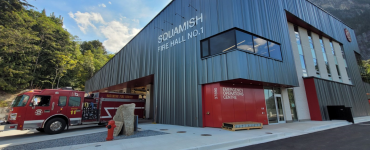
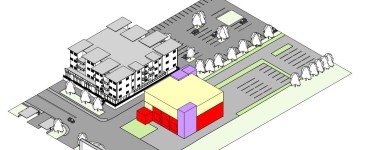
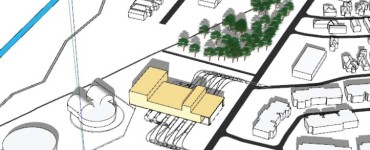

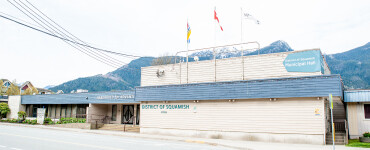
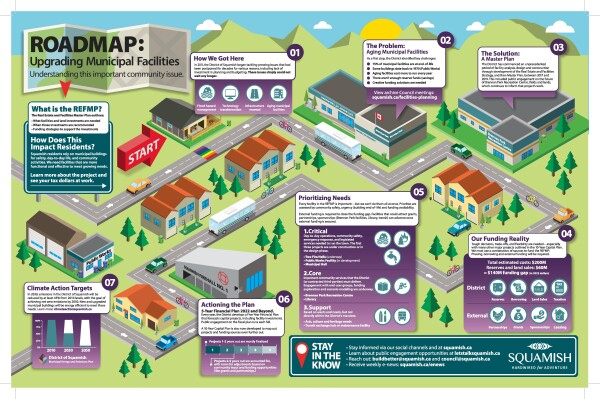
Post your comment
Comments
No one has commented on this page yet.
RSS feed for comments on this page | RSS feed for all comments